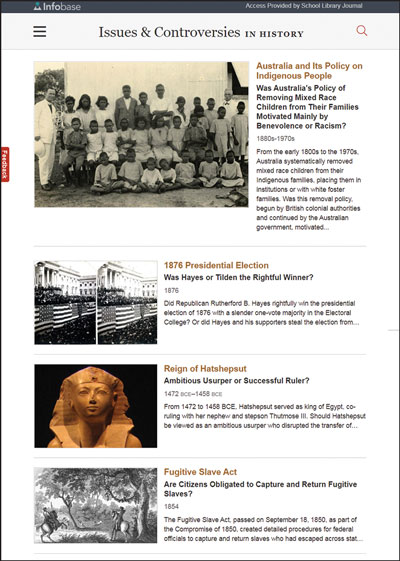Infobase’s Issues & Controversies in History | Reference Database Review
Formerly known as Issues & Controversies in American History, this updated and significantly expanded research database frames historical topics as debates between two contrasting perspectives.
 Infobase’s Issues & Controversies in History
Infobase’s Issues & Controversies in History
Grade Level Gr 9 Up
Cost Pricing is determined by full-time enrollment for schools and by number of cardholders for public libraries. Consortia pricing is also available.
Content Formerly known as Issues & Controversies in American History, this updated and significantly expanded research database frames historical topics as debates between two contrasting perspectives.
On the left side of the home page, users will find a list of featured articles, such as “1876 Presidential Election: Was Hayes or Tilden the Rightful Winner?” On the right side of the home page, a menu lists featured resources (time lines, editorial cartoons, etc.), American history eras (from “Beginnings to 1606” to the present), world history eras (from prehistory to the present), and history regions and subjects.
The articles skew toward U.S. history. A page on “women and gender,” for instance, features a piece called “Reign of Hatshepsut: Ambitious Usurper or Successful Ruler?” while the remaining 18 topics are U.S.-specific.
A navigation bar at the top of each article allows users to move among the main pro/con article, a time line, a list of primary sources, links to related articles from elsewhere in the database, and a “learn more” page with links to supplemental Infobase articles and outside websites. (These links to external sites are not active but have to be copied and pasted.)
The topics under consideration are necessarily controversial. Arguments both for and against the questions are rooted in historical records and are amply cited within the text.
However, though the articles don’t advocate racist arguments, some of the language is problematic. The article on the Fugitive Slave Act of 1850, a key issue in the lead-up to the Civil War, discusses slavery without any explicit discussion of racism or white supremacy. The article title—“The Fugitive Slave Act: Are Citizens Obligated to Capture and Return Fugitive Slaves?”—also frames the issue as though both sides are equally valid.
At times, positions and arguments are presented without necessary context and sometimes even repeats hateful language. One piece asks if the forced removal of mixed-race children from Indigenous households in Australia throughout the 20th century was motivated by racism or by benevolence—a problematic framing, given that racism is at the heart of the argument that removal was beneficial (“Many Indigenous communities were marked by squalor and poverty, advocates of removing mixed race children argued”).
Student and teacher resources The site supports single-sign-on with Google or Microsoft. A search box, along with links for advanced search and browsing of learning standards, can be found at the top of every page.
The advanced search function uses Boolean operators; users can add rows to create more complex searches. A search options menu allows for searching all record types or restricting results to articles, primary sources, or images.
Users can browse by standards for all 50 states and Washington, DC; Common Core; IB; AP; and some national and international frameworks. They can also search by grade level (eight through 12) and subject area (though only social studies is available).
Articles can be saved (if the student has set up a personal account), downloaded, copied to Google Drive, posted to Google Classroom, emailed, printed, or embedded in a learning management system. Students can generate a citations in MLA, Chicago, Harvard, or APA styles; citations can be exported to EasyBib or NoodleTools. Articles can be read aloud in an automated but clear voice. A bibliography and list of discussion questions appear below each article.
Educator resources include a list of discussion questions arranged chronologically. A star icon identifies the items that feature an “enhanced lesson,” including video clips, learning objectives, activity handouts, and more. The videos are brief and include citation information and a transcript that highlights the text as the video plays. Video links can be shared and embedded in HTML pages. The transcript box may be hidden for playback and videos may be viewed in full-screen mode.
Curriculum tools include short articles for students and teachers on analyzing editorial cartoons, evaluating online sources, and learning through debate.
A Google Translate feature at the bottom of each page allows instant translation to more than 100 languages.
Verdict Coverage of the subjects is vast, particularly in U.S. history topics, and documentation of sourcing is excellent. Site navigation is intuitive and clear. However, this resource suffers in some areas where history is framed through false dichotomies and not enough context is offered. Libraries where inquiry-based learning is being practiced can select as needed.
Bob Hassett, Luther Jackson M.S., Falls Church, VA
RELATED
The job outlook in 2030: Librarians will be in demand
The job outlook in 2030: Librarians will be in demand
ALREADY A SUBSCRIBER? LOG IN
We are currently offering this content for free. Sign up now to activate your personal profile, where you can save articles for future viewing






Add Comment :-
Be the first reader to comment.
Comment Policy:
Comment should not be empty !!!